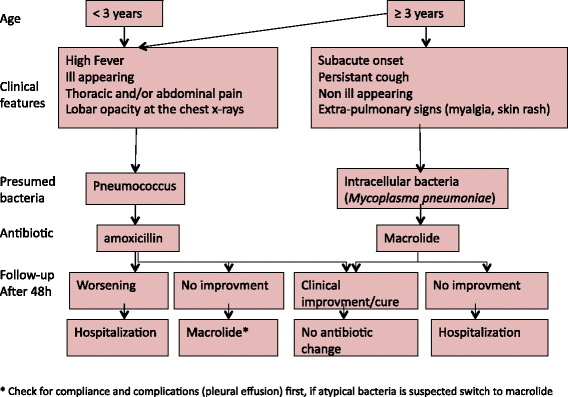Compliance with the current recommendations for prescribing antibiotics for paediatric community-acquired pneumonia is improving: data from a prospective study in a French network
- PMID: 27520057
- PMCID: PMC4983061
- DOI: 10.1186/s12887-016-0661-3
Compliance with the current recommendations for prescribing antibiotics for paediatric community-acquired pneumonia is improving: data from a prospective study in a French network
Abstract
Background: Lower respiratory tract infection is a common cause of consultation and antibiotic prescription in paediatric practice. The misuse of antibiotics is a major cause of the emergence of multidrug-resistant bacteria. The aim of this study was to evaluate the frequency, changes over time, and determinants of non-compliance with antibiotic prescription recommendations for children admitted in paediatric emergency department (PED) with community-acquired pneumonia (CAP).
Methods: We conducted a prospective two-period study using data from the French pneumonia network that included all children with CAP, aged one month to 15 years old, admitted to one of the ten participating paediatric emergency departments. In the first period, data from children included in all ten centres were analysed. In the second period, we analysed children in three centers for which we collected additional data. Two experts assessed compliance with the current French recommendations. Independent determinants of non-compliance were evaluated using a logistic regression model. The frequency of non-compliance was compared between the two periods for the same centres in univariate analysis, after adjustment for confounding factors.
Results: A total of 3034 children were included during the first period (from May 2009 to May 2011) and 293 in the second period (from January to July 2012). Median ages were 3.0 years [1.4-5] in the first period and 3.6 years in the second period. The main reasons for non-compliance were the improper use of broad-spectrum antibiotics or combinations of antibiotics. Factors that were independently associated with non-compliance with recommendations were younger age, presence of risk factors for pneumococcal infection, and hospitalization. We also observed significant differences in compliance between the treatment centres during the first period. The frequency of non-compliance significantly decreased from 48 to 18.8 % between 2009 and 2012. The association between period and non-compliance remained statistically significant after adjustment for confounding factors. Amoxicillin was prescribed as the sole therapy significantly more frequently in the second period (71 % vs. 54.2 %, p < 0.001).
Conclusions: We observed a significant increase in the compliance with recommendations, with a reduction in the prescription of broad-spectrum antibiotics, efforts to improve antibiotic prescriptions must continue.
Keywords: Antibiotic prescription; Antibiotic stewardship; Children; Pneumonia.
Figures
References
Publication types
MeSH terms
Substances
LinkOut - more resources
Full Text Sources
Other Literature Sources
Medical
Miscellaneous


